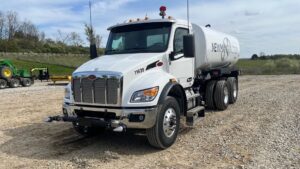Key Specifications of 4×4 Commercial Trucks
4×4 commercial trucks are built to excel in demanding environments and challenging terrains. Their design elements focus on durability, stability, and power, making them indispensable for various industrial tasks. Here are some primary specifications and features that distinguish these trucks.
1. Four-Wheel Drive System (4×4)
The four-wheel-drive system is the core feature of these trucks, providing enhanced traction and control across uneven and slippery terrains. The drivetrain is designed to distribute power to all four wheels, allowing the vehicle to maintain stability on muddy, snowy, or rocky surfaces. This capability is critical for applications in remote and undeveloped areas where traditional two-wheel-drive vehicles might get stuck or lack control.
- Manual vs. Automatic 4×4 Modes: Some trucks offer the flexibility of shifting between two-wheel-drive and four-wheel-drive modes, helping optimize fuel efficiency when 4×4 power isn’t required. Advanced models may feature automatic systems that adjust based on terrain, ensuring optimal traction.
2. Engine Power and Torque
4×4 commercial trucks typically come equipped with high-performance engines, often V6 or V8, or in some heavy-duty applications, turbo-diesel engines with increased torque output. These engines are designed to handle the rigorous demands of towing, hauling, and prolonged off-road use. Diesel engines, in particular, are favored for their efficiency and power, delivering higher torque at lower RPMs, which is ideal for towing and hauling in rough conditions.
- Horsepower Range: Many 4×4 commercial trucks offer horsepower ranging from 250 to over 450 HP, depending on the truck’s purpose. Heavy-duty models can exceed 500 HP for extreme towing and hauling.
- Torque: Diesel engines can provide up to 1,000 lb-ft of torque, allowing for smooth towing of heavy loads and improved performance on steep gradients.
3. High Ground Clearance
Designed for off-road use, 4×4 trucks often feature high ground clearance to avoid obstacles and prevent undercarriage damage on rough terrains. Clearance heights generally range from 8 to 12 inches, with some specialized trucks offering even higher clearance for extreme conditions. Adjustable or air suspensions allow users to raise or lower the vehicle as needed, which adds flexibility when driving over rocks, through deep snow, or in muddy fields.
4. Heavy-Duty Suspension System
4×4 trucks incorporate durable suspension systems that support heavy loads and provide stability over uneven surfaces. Leaf springs or coil springs with shock absorbers are common in these trucks, and they’re built to handle both on-road and off-road conditions. Many models also offer additional components such as sway bars and stabilizer links, which improve handling on challenging surfaces and help maintain control when the vehicle is heavily loaded.
5. Payload and Towing Capacity
One of the biggest advantages of 4×4 commercial trucks is their high payload and towing capacities. Reinforced frames, powerful engines, and efficient powertrains enable these trucks to handle loads that range from several thousand pounds up to 37,000 pounds in specialized models. Payload capacity varies significantly depending on the model, with light-duty 4×4 trucks offering around 1,500 to 3,000 pounds and heavy-duty models handling 6,000 pounds or more.
- Towing Capacities: Light-duty 4×4 trucks can tow between 5,000 and 10,000 pounds, while medium-duty models handle around 15,000 to 25,000 pounds. For extremely demanding tasks, heavy-duty 4×4 trucks can tow loads exceeding 30,000 pounds.
6. Tire Specifications and Off-Road Capability
Most 4×4 commercial trucks are equipped with all-terrain or mud-terrain tires designed for optimal performance in rough conditions. These tires feature larger treads and durable sidewalls to enhance grip on loose, rocky, or uneven surfaces. Some manufacturers also offer optional tire upgrades and modifications for specialized off-road applications, including snow and sand tires.
- Tire Size: Typical tire sizes range from 17 to 22 inches, with larger tires available for more extreme off-road use.
- Traction Control Systems: Advanced 4×4 trucks may feature traction control and stability control systems, ensuring the wheels maintain grip in slippery or steep conditions, preventing slippage and rollovers.
7. Fuel Capacity and Efficiency
While 4×4 trucks are not typically known for fuel efficiency, modern models have made strides in fuel-saving technology. Diesel engines, in particular, offer better mileage and are more fuel-efficient for long hauls or heavy loads. Additionally, larger fuel tanks, often 30 to 50 gallons, allow for longer operating times, which is beneficial in remote areas where fuel stations are scarce.
Applications of 4×4 Commercial Trucks Across Industries
The robust specifications of 4×4 trucks make them ideal for a variety of industrial applications:
a) Construction and Heavy-Duty Applications
4×4 trucks are staples on construction sites, where they transport equipment, materials, and workers across challenging terrains. Their towing power allows them to haul trailers, generators, and heavy machinery. Many trucks in this category are outfitted with custom beds and tool storage, further enhancing their utility for construction tasks.
b) Agricultural Use
In agriculture, 4×4 trucks navigate farmlands, transporting feed, equipment, and livestock over muddy or uneven terrain. Attachments such as seed spreaders, spray tanks, or livestock racks are available to make these trucks multi-functional on farms. Their reliability and ease of access to fields make them essential during planting and harvesting seasons.
c) Emergency and Rescue Services
For emergency response teams, 4×4 trucks provide the power, control, and storage capacity to bring supplies and personnel to remote locations. Fire departments, search and rescue teams, and paramedics rely on these trucks to reach areas cut off by floods, fires, or earthquakes. The reinforced build and durability of these trucks make them suitable for transporting critical equipment and supplies in high-stakes situations.
d) Utilities and Infrastructure Maintenance
Utility companies need to access remote or difficult-to-reach areas to maintain infrastructure like power lines, water systems, and pipelines. 4×4 trucks enable these teams to carry heavy tools and equipment while traversing challenging terrains. Many utility trucks come equipped with crane attachments or bucket lifts, allowing workers to repair equipment in elevated locations.
e) Forestry and Environmental Services
In forestry, 4×4 trucks are necessary for carrying logging equipment and personnel deep into the forest. These trucks can handle steep inclines, muddy paths, and other environmental obstacles. Forestry trucks are often modified with winches, additional lighting, and off-road tires, making them suited for logging and wildlife management.
Benefits and Considerations
Benefits
- Enhanced Traction: The four-wheel-drive system ensures better handling and stability on difficult terrain.
- Increased Payload and Towing: Reinforced frames and powerful engines make these trucks capable of handling heavy loads.
- Customization: Extensive options for attachments and configurations make 4×4 trucks adaptable to specific industries.
- Durability: Built with heavy-duty materials, these trucks are designed for longevity and can withstand frequent use in challenging environments.
Considerations
- Higher Cost: Due to their advanced systems and durability, 4×4 trucks are generally more expensive than two-wheel-drive models.
- Fuel Efficiency: Despite improvements, fuel consumption remains relatively high, particularly for heavy-duty models.
- Maintenance: The added complexity of four-wheel-drive systems increases maintenance needs and costs.
Conclusion
4×4 commercial trucks are indispensable assets in a wide range of industries, providing the power, reliability, and adaptability needed for tough jobs in remote or challenging conditions. Their high towing capacities, durability, and customizability make them ideal for construction, agriculture, emergency services, and more. While they require a significant investment, the benefits they offer in productivity, safety, and efficiency often justify the cost. With advances in fuel technology and sustainability, 4×4 commercial trucks are poised to continue evolving, ensuring their relevance and importance in the years to come.




